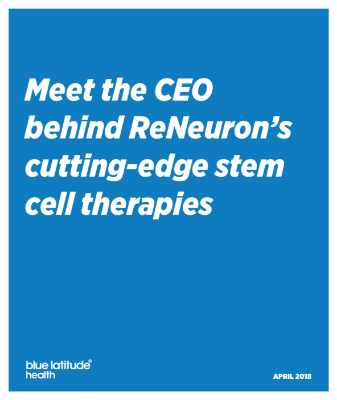Meet the CEO behind ReNeuron’s cutting-edge stem cell therapies
April 18, 2018 | 21st century cures, Innovation, New product, Product Launch, Stem cell, Stroke, biotech, cell and gene, first in class product, product development, product marketing
Blue Latitude Health speaks to Olav Hellebo, CEO of ReNeuron, to find out about the biotech’s latest innovation in stem cell therapy and to learn his perspective on navigating the challenges that come with developing products in this complex market.

Image: Olav Hallebo, CEO, ReNeuron
The global stem cell market is predicted to reach $270.5bn by 2025. Currently, biotech companies and big pharma are pouring money into this sector, in the hope of advancing research and development and discovering the next big breakthrough.
However, as investment grows and organisations expand with diverse product portfolios, the market is also predicted to become more competitive and complex.More than five-and-a-half million people in the US suffer from Alzheimer’s disease, and 795,000 Americans suffer from strokes annually.
Cellular therapies are quickly becoming seen as the transformative step in treating these chronic ailments. This, coupled with growing investment in the sector and an increasing number of stem cell donors, is propelling the market forwards.
One company making an impact in this area is ReNeuron. The biotech creates ‘off-the-shelf’ cell-based therapies, including a CTX stem cell therapy that aims to treat patients who have been left disabled after a stroke, months or even years after the stroke has occurred.
A phase II study has been completed with promising results, in which 15 out of 21 patients showed a clinically significant response, meaning the therapy could be revolutionary for stroke victims.Blue Latitude Health spoke to ReNeuron CEO Olav Hellebo to find out about the commercial and strategic challenges he faces when bringing products to market, and the lessons he’s learned along the way.
The half-light of the truth
Prior to landing the job of CEO in 2014, Olav held positions in clinical development, out-licensing, commercialisation and the marketing of new products at both biotechs and big pharma organisations. As a result, he is experienced in the commercial ups and downs of creating innovative first-in-class drugs.
Commercial strategy in biotech differs dramatically from other industries, with each organisation on the quest for the next big thing. Olav reveals: “The half-light of the truth is quite short, a lot is affected by fashion. Everyone runs for the same thing, at the same time and everyone believes they are pursuing the truth.”
For Olav, the struggle to diversify comes down to one thing – fear of the unknown. “It’s a little bit like it was in the old days of buying IBM computers,” he says. “You knew you would never be fired if you bought an IBM computer because everyone else had them, so if something went wrong you were just one of the crowd. If you go against the grain and you’re licensing something people are sceptical of, you can end up a hero. If it doesn’t go well, you get a new job in the cafeteria.”
Flexibility can be crucial to an effective strategic approach.Olav points to the acquisition of Schering-Plough by Merck as an example of the hidden rewards of taking an elastic perspective to expanding your portfolio.
In 2009, Merck bought its rival Schering-Plough for $41.1bn in a bid to diversify. The pharma giant’s aim was to acquire the cholesterol inhibitor Vytorin, a product it had been hoping to develop before being been beaten to the finish line by its competitor. However, hidden in the pipeline was the ‘miracle’ immuno-oncology drug Keytruda. “You have this fantastic jewel that nobody really noticed but in the end it’s a major discovery – the PD1 inhibitor, T cell therapy,” Olav says emphatically.
Download the full article from Blue Latitude Health
This content was provided by Blue Latitude Health




